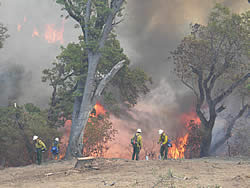Forests and Rangelands Success Story
U.S. Fish and Wildlife Service Firefighters Gain Critical Experience
Interagency Fire Crew, Kansas
National Fire Plan - Firefighting
2008

The Mid Plains interagency hand crew fights fire with fire on the northwest side of the Basin Complex Fire in California helping to keep the fire from reaching a narrow canyon where many homes are located.
Firefighters from the U.S. Fish and Wildlife Service have been actively working along side firefighters from other federal, state, and local fire agencies as members of the Mid Plains interagency wildland fire crew. The 20-person crew is comprised of firefighters from the U.S. Fish and Wildlife Service, U.S. Forest Service, Bureau of Indian Affairs, National Park Service, Kansas Forest Service, as well as municipal fire departments from the greater Denver area. Each time the crew gets called to a fire, firefighters from these agencies unite to form a firefighting hand crew.
"Typically at least 50 percent of the crew is made up of U.S. Fish and Wildlife Service firefighters," said Bill Waln, Fire Management Officer at Quivira National Wildlife Refuge. "Our agency sees the crew as a perfect opportunity to help develop the future leaders of our fire program."
Part of the intent of the Mid Plains crew is to provide firefighters from the various fire agencies an opportunity to gain critical on-the-ground experience that will benefit them throughout their career in fire. In a crew setting such as this, firefighters also get a chance to develop and fine tune leadership skills during a fire situation.
Critical to ensuring a crew’s safety, which is always the top priority in all wildland fire fighting operations, is strong leadership and teamwork. To strengthen these attributes, a qualified crew boss from one of the agencies takes charge of the group for the duration of their fire assignment which typically last for 14 days.
Since the crew is made up of different people from different agencies each time they are sent to an incident, fire bosses from the area provide a week-long training opportunity each year prior to fire season for all potential firefighters that may participate on the crew during the season. As part of the week, the firefighters go through formally sanctioned firefighter training as well as practical and field training. The objective is for potential crew members to have a sense of cohesion early in the year that will carry into any fire assignments.
So far this season, the Mid Plains crew has completed two assignments to fight fire in California each lasting for two weeks and recently was sent to fight a fire in Wyoming.